Most innovative companies for 07/23/2024 (new inventions)
Exciting new inventions from Qualcomm Incorporated, Samsung Electronics Co., Ltd., Apple Inc. And International Business Machines Corporation
This is a weekly article summarizing a handful of inventions from the most innovative companies in the world. The summaries are created by an A. I. and proof-read by a human before publication. Attempts are made to ensure accuracy of the descriptions, but it is very much a work in progress. Each invention description is preceeded by a poem about the invention that is written by the A. I. I have found the limerick is actually quite good at explaining the invention in simple terms. Enjoy!
QUALCOMM Incorporated
"Efficient XR Workload Management: Qualcomm's Patent Revolutionizes Power and Performance Optimization"
What is this invention?
Technique to optimize power and performance of XR workload
In tech's realm of power and force,
Systems tailor XR workload's course.
From storage, programs take flight,
Optimizing with might,
Graphics processor, efficiency's source.
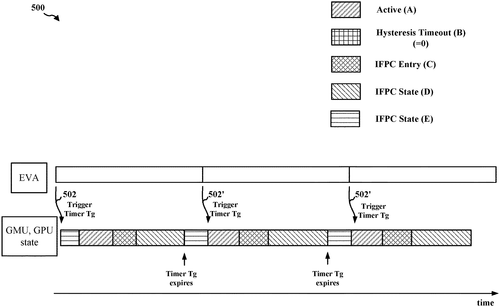
In a recent patent filing by Qualcomm Incorporated, a new system is being proposed to optimize power and performance for extended reality (XR) workloads. This system involves a graphics processor that can efficiently manage the processing of specific workloads, entering and exiting a power-saving state as needed. Competitors in the XR space, such as Oculus and HTC, currently offer VR and AR products that focus on immersive experiences, but often struggle with power efficiency and performance optimization. With Qualcomm's new system, potential uses could include enhancing battery life for XR devices, improving overall performance, and creating a more seamless user experience for virtual and augmented reality applications. Will this patent from Qualcomm lead to groundbreaking advancements in XR technology, or will it remain just a concept on paper? How do you think power and performance optimization will shape the future of XR experiences? Share your thoughts in the comments below.
Abstract
This disclosure provides systems, devices, apparatus, and methods, including computer programs encoded on storage media, for optimizing power and performance of XR workloads. A graphics processor may receive, from an application, an indication of a time period for a timer associated with exiting an IFPC state. The graphics processor may process, upon triggering the timer associated with exiting the IFPC state, one or more predefined workloads. The graphics processor may initiate the IFPC state upon the one or more predefined workloads being finished processing. The graphics processor may exit the IFPC state upon detecting an expiration of the timer. This disclosure provides systems, devices, apparatus, and methods, including computer programs encoded on storage media, for optimizing power and performance of XR workloads. A graphics processor may receive, from an application, an indication of a time period for a timer associated with exiting an IFPC state. The graphics processor may process, upon triggering the timer associated with exiting the IFPC state, one or more predefined workloads. The graphics processor may initiate the IFPC state upon the one or more predefined workloads being finished processing. The graphics processor may exit the IFPC state upon detecting an expiration of the timer.
US Patent 12045910
QUALCOMM Incorporated
"Enhancing Ray Tracing Processor Operations with Cache-Aligned Nodes: Qualcomm's Latest Patent Breakthrough"
What is this invention?
Ray tracing processor
In the realm of ray tracing's grace,
Enhancing operations we embrace.
Nodes in cache, aligned just right,
Processed swiftly, day and night,
Technology's poetry in each clock cycle's pace.

A recently filed patent by QUALCOMM Incorporated proposes systems and techniques to optimize the performance of a ray tracing processor. The concept involves storing nodes in a cache aligned with the processor, allowing for efficient processing in clock cycles. While this innovation holds promise for enhancing graphics rendering and computational efficiency, it remains to be seen if it will materialize into a market-ready product. Competitors such as NVIDIA and AMD have been at the forefront of developing advanced graphics processing units for gaming and professional applications. By improving the operations of ray tracing processors, this new patent could potentially offer a competitive edge in the market, enabling faster and more realistic graphics rendering in real-time applications. The application of this technology could extend beyond gaming, impacting industries such as virtual reality, simulation, and architectural visualization. Imagine the possibilities of enhanced visual fidelity and smoother performance in virtual environments or real-time rendering for architectural design presentations. As we look towards the future of graphics processing, the question arises: Will advancements in ray tracing processors pave the way for a new era of immersive digital experiences? Share your thoughts in the comments below.
Abstract
Systems and techniques are provided for enhancing operations of a ray tracing processor. For instance, a process can include obtaining one or more nodes of an acceleration data structure. Each node of the one or more nodes includes the same number of bytes. The node(s) can be stored in a cache associated with a ray tracing processor. Each of the stored node(s) are cache line-aligned with the cache associated with the ray tracing processor. A first stored node of the stored node(s) can be provided to the ray tracing processor and processed by the ray tracing processor during a first clock cycle of the ray tracing processor. A second stored node of the stored node(s) can be provided to the ray tracing processor and processed by the ray tracing processor during a second clock cycle of the ray tracing processor. Systems and techniques are provided for enhancing operations of a ray tracing processor. For instance, a process can include obtaining one or more nodes of an acceleration data structure. Each node of the one or more nodes includes the same number of bytes. The node(s) can be stored in a cache associated with a ray tracing processor. Each of the stored node(s) are cache line-aligned with the cache associated with the ray tracing processor. A first stored node of the stored node(s) can be provided to the ray tracing processor and processed by the ray tracing processor during a first clock cycle of the ray tracing processor. A second stored node of the stored node(s) can be provided to the ray tracing processor and processed by the ray tracing processor during a second clock cycle of the ray tracing processor.
US Patent 12045928
QUALCOMM Incorporated
"Pioneering Display Processing: Qualcomm's Innovative DPU Technology Revolutionizes Subpixel Calibration"
What is this invention?
Adaptive subsampling for demura corrections
In display processing, we look to see
Methods and devices, oh so techy
An apparatus, a DPU at the helm
Adjusting subpixels, keeping them in perfect realm
Precision and accuracy, a futuristic spree
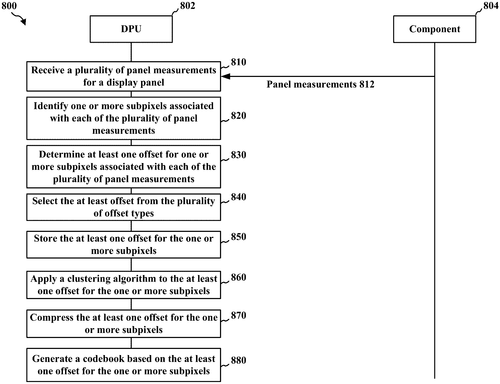
A new patent from Qualcomm Incorporated has caught the attention of tech enthusiasts, hinting at potential advancements in display processing technology. The patent describes methods and devices for optimizing display panel performance, including the use of a Digital Processing Unit (DPU). The apparatus outlined in the patent is designed to receive and analyze multiple measurements from a display panel's subpixels. By determining and storing offsets for specific subpixels, the apparatus aims to enhance the overall quality and accuracy of the displayed content. With competitors in the display technology sector constantly pushing boundaries with cutting-edge products, Qualcomm's patent could potentially offer a competitive edge in the market. Imagine displays with unparalleled clarity and color accuracy, setting new standards for visual experiences across various devices. But, as with many patents, the question remains: will this innovative display processing technology actually make its way into consumer products? How would you envision this advancement enhancing your daily interaction with screens? Share your thoughts below.
Abstract
The present disclosure relates to methods and devices for display processing including an apparatus, e.g., a DPU. The apparatus may receive a plurality of panel measurements for a display panel, each of the plurality of panel measurements associated with a plurality of subpixels in the display panel. The apparatus may also determine, upon receiving the plurality of panel measurements, at least one offset for one or more subpixels of the plurality of subpixels associated with each of the plurality of panel measurements. The apparatus may also store, upon determining the at least one offset for the one or more subpixels, the at least one offset for the one or more subpixels associated with each of the plurality of panel measurements. The present disclosure relates to methods and devices for display processing including an apparatus, e.g., a DPU. The apparatus may receive a plurality of panel measurements for a display panel, each of the plurality of panel measurements associated with a plurality of subpixels in the display panel. The apparatus may also determine, upon receiving the plurality of panel measurements, at least one offset for one or more subpixels of the plurality of subpixels associated with each of the plurality of panel measurements. The apparatus may also store, upon determining the at least one offset for the one or more subpixels, the at least one offset for the one or more subpixels associated with each of the plurality of panel measurements.
US Patent 12046192
QUALCOMM Incorporated
"Qualcomm's Innovative Filter Circuit Revolutionizes Signal Filtering Technology"
What is this invention?
Matching network with tunable notch filter
In a filter circuit with matching network grace,
Resistive and capacitive elements embrace,
A transformer adds its magic touch,
Primary and secondary sides clutch,
Interwinding capacitance in place.
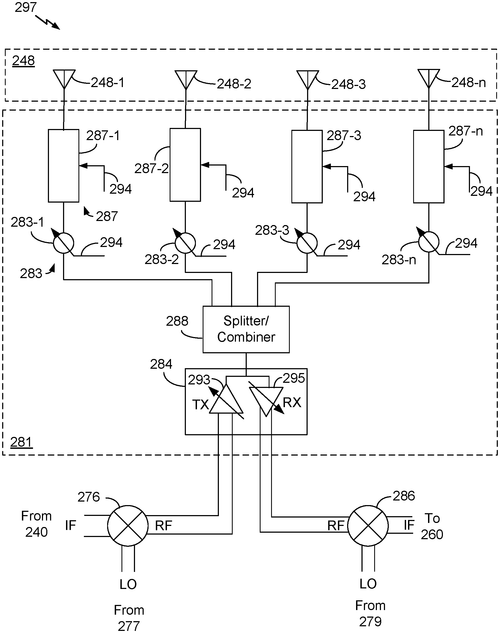
Qualcomm Incorporated has recently patented a new filter circuit that incorporates a matching network with resistive and capacitive elements, along with a transformer. This transformer features a primary side and a secondary side, and is designed with at least one interwinding capacitance linking the primary and secondary sides. While the technical details may sound complex, the potential applications of this filter circuit are vast. Imagine improved signal processing capabilities in telecommunications devices, enhanced audio quality in consumer electronics, or even better filtering in medical equipment. Competitors in the market, such as Intel and Broadcom, may need to take note of this innovative patent from Qualcomm. If this filter circuit makes its way into actual products, it could potentially give Qualcomm an edge in the technology industry. Will this patented filter circuit revolutionize signal processing in the tech world? How do you think it could impact the future of telecommunications and consumer electronics? Share your thoughts in the comments below.
Abstract
A filter circuit includes a matching network having resistive and capacitive elements, and a transformer in the matching network. The transformer includes a primary side and a secondary side, and has at least one interwinding capacitance coupled from an input on the primary side to a non-inverting output on the secondary side. A filter circuit includes a matching network having resistive and capacitive elements, and a transformer in the matching network. The transformer includes a primary side and a secondary side, and has at least one interwinding capacitance coupled from an input on the primary side to a non-inverting output on the secondary side.
US Patent 12047051
QUALCOMM Incorporated
"QUALCOMM's Innovative Patent Reduces Leakage Current with Cutting-Edge Technology"
What is this invention?
Power supply circuit with reduced leakage current
A switch circuit to power with might,
A delay circuit delays the light,
Bypass it to stop,
Leakage current drop,
Reducing power with tech that's bright.
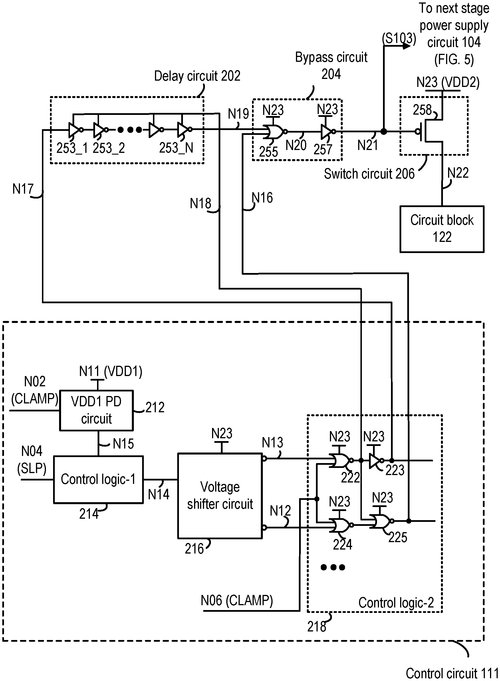
In the world of tech patents, QUALCOMM Incorporated has presented a new invention aimed at reducing leakage current in circuit blocks. This innovative idea involves a switch circuit, a delay circuit, and a bypass circuit working together to efficiently power and disable the circuit block as needed. Competitors in the market offering similar solutions may find themselves keeping a close eye on this patent from QUALCOMM. With the potential to enhance power management in electronics, this invention could have a wide range of applications in various devices, from smartphones to laptops. However, as with many patents, the question remains - will this technology actually make it to the mass market? While the concept is intriguing, only time will tell if consumers will see this innovation in products they use every day. What are your thoughts on this new development in power management technology? Feel free to share your opinions in the comments below.
Abstract
Apparatuses and methods to reduce leakage current are presented. The includes a switch circuit configured to power a circuit block; a delay circuit configured to delay enabling the switch circuit powering the circuit block and to be powered down; and a bypass circuit configured to bypass the delay circuit to disable the switch circuit powering the circuit block. The method includes powering, by switch, a circuit block; powering down a delay circuit; and bypassing, by a bypass circuit, the delay circuit to disable the switch circuit powering the circuit block. Apparatuses and methods to reduce leakage current are presented. The includes a switch circuit configured to power a circuit block; a delay circuit configured to delay enabling the switch circuit powering the circuit block and to be powered down; and a bypass circuit configured to bypass the delay circuit to disable the switch circuit powering the circuit block. The method includes powering, by switch, a circuit block; powering down a delay circuit; and bypassing, by a bypass circuit, the delay circuit to disable the switch circuit powering the circuit block.
US Patent 12047073
Samsung Electronics Co., Ltd.
"Samsung Patents Innovative Foldable Electronic Device Case with Rotating Covers and Angle Adjustment"
What is this invention?
Case for foldable electronic device
In the world of tech so grand,
A foldable device in hand,
With covers that rotate,
Information they correlate,
Innovation at its command.
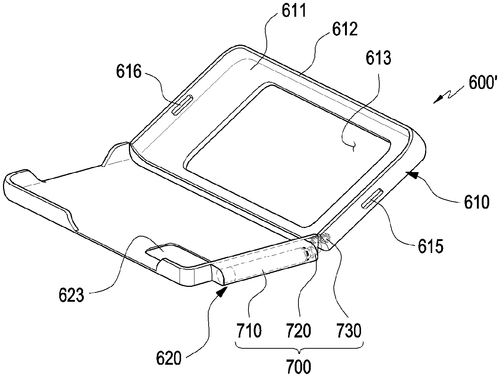
Samsung Electronics Co., Ltd. has recently patented a case for a foldable electronic device that has tech enthusiasts buzzing with excitement. The case features a first housing and a second housing that can rotate with respect to each other, with covers that adjust their angle using a driving unit. This innovation allows for seamless communication between the case and the foldable electronic device, enhancing user experience. While Samsung's foldable phone lineup is already making waves in the market, this new patented case could potentially take the user experience to the next level by providing added functionality and convenience. It could also give competitors, such as Apple and Huawei, a run for their money in the foldable devices segment. Imagine a future where your foldable smartphone case not only protects your device but also enhances its usability with adjustable covers and seamless communication capabilities. The possibilities for this technology are endless, from hands-free video calls to improved gaming experiences. Will Samsung be able to bring this innovative foldable electronic device case to the market and revolutionize the way we interact with our devices? Share your thoughts in the comments below.
Abstract
Various embodiments of the present disclosure provide a case for a foldable electronic device, comprising a first housing and a second housing rotatable with respect to the first housing. The case may comprise: a first cover at least partially covering the first housing; a second cover at least partially covering the second housing and rotatable with respect to the first cover; a driving unit for adjusting the angle between the first cover and the second cover; a communication unit for transmitting or receiving information relating to the angle to or from the foldable electronic device; and at least one processor connected to the communication unit so as to receive the information relating to the angle and drive the driving unit accordingly. Various other embodiments may be employed. Various embodiments of the present disclosure provide a case for a foldable electronic device, comprising a first housing and a second housing rotatable with respect to the first housing. The case may comprise: a first cover at least partially covering the first housing; a second cover at least partially covering the second housing and rotatable with respect to the first cover; a driving unit for adjusting the angle between the first cover and the second cover; a communication unit for transmitting or receiving information relating to the angle to or from the foldable electronic device; and at least one processor connected to the communication unit so as to receive the information relating to the angle and drive the driving unit accordingly. Various other embodiments may be employed.
US Patent 12042031
Samsung Electronics Co., Ltd.
"Samsung's Innovative Bio-Electroceutical Device Pioneers Controlled Cell Secretion"
What is this invention?
Bio-electroceutical device using cell cluster
In the realm of technology so grand,
A bio-electroceutical band,
With cell reservoir snug,
And controller that's plugged,
Secretes actives as we command!
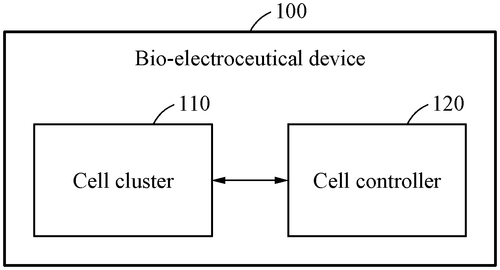
Samsung Electronics Co., Ltd. recently filed a patent for a bio-electroceutical device that sounds straight out of a science fiction novel. The device boasts a cell reservoir designed to house a cell cluster containing an organoid fused with a biomaterial, along with a cell controller that can regulate the secretion of active components by the organoid through electrical signals. This innovation could potentially revolutionize the field of bioelectronics. In a market already saturated with wearable health monitoring devices from competitors like Apple and Fitbit, Samsung's bio-electroceutical device presents a unique approach by delving into the realm of bio-electronics. Imagine a future where patients can receive targeted and personalized treatments through the precise control of active components in their organoids, offering new possibilities for medical advancements and personalized medicine. While the concept laid out in the patent is undeniably fascinating, the practicality of bringing such a sophisticated device to the consumer market remains uncertain. How would the integration of this bio-electroceutical device impact the traditional healthcare system? Would individuals be willing to adopt such groundbreaking technology for their health needs, or does the idea of bioelectric medicine still seem like science fiction to the average consumer? Share your thoughts in the comments below.
Abstract
A bio-electroceutical device includes: a cell reservoir configured to accommodate a cell cluster comprising an organoid fused with a biomaterial; and a cell controller configured to control, using an electrical signal, a secretion of an active component by the organoid in the cell cluster. A bio-electroceutical device includes: a cell reservoir configured to accommodate a cell cluster comprising an organoid fused with a biomaterial; and a cell controller configured to control, using an electrical signal, a secretion of an active component by the organoid in the cell cluster.
US Patent 12042629
Samsung Electronics Co., Ltd.
"Samsung's Innovative Wafer Cleaning Apparatus Incorporates Laser Technology for Superior Results"
What is this invention?
Wafer cleaning apparatus and wafer cleaning method using the same
In a chamber a wafer lies still,
With liquid chemicals to thrill,
A laser module shines bright,
On the wafer's surface with might,
Cleaning apparatus with precision and skill.
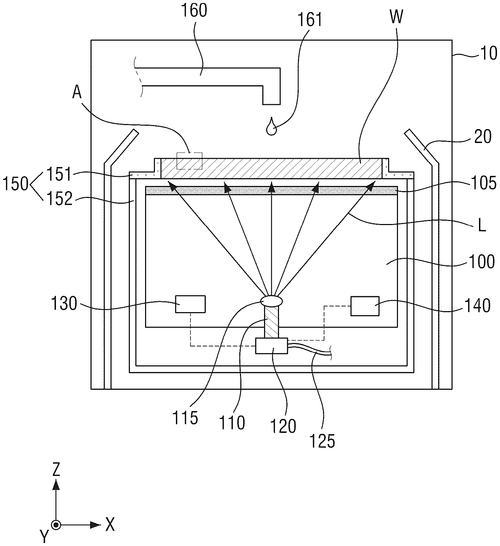
Samsung Electronics Co., Ltd. has patented a fascinating wafer cleaning apparatus that incorporates a chamber, a nozzle for liquid chemicals, a laser module, and a controller to ensure precise cleaning and temperature control of wafers. This invention signals a potential breakthrough in semiconductor manufacturing technology, offering a new approach to wafer cleaning that could enhance efficiency and quality in the production process. Competitors in the semiconductor industry, such as Intel and TSMC, are constantly striving to improve manufacturing techniques to gain a competitive edge. Samsung's innovative use of laser technology in wafer cleaning could set them apart in this race for technological advancement. Imagine the potential uses of this cutting-edge wafer cleaning apparatus in not only the semiconductor industry but also in other precision manufacturing processes where cleanliness and temperature control are crucial. Could this patented invention revolutionize how various industries handle delicate surfaces and components in their production lines? Share your thoughts in the comments below.
Abstract
A wafer cleaning apparatus is provided. The wafer cleaning apparatus includes comprising a chamber configured to be loaded with a wafer, a nozzle on the wafer and configured to provide liquid chemicals on an upper surface of the wafer, a housing under the wafer, a laser module configured to irradiate laser on the wafer, a transparent window disposed between the wafer and the laser module, and a controller configured to control on/off of the laser module, wherein the controller is configured to control repetition of turning the laser module on and off, and retain temperature of the wafer within a temperature range, and a ratio of time when the laser module is on in one cycle including on/off of the laser module is 30% to 50%. A wafer cleaning apparatus is provided. The wafer cleaning apparatus includes comprising a chamber configured to be loaded with a wafer, a nozzle on the wafer and configured to provide liquid chemicals on an upper surface of the wafer, a housing under the wafer, a laser module configured to irradiate laser on the wafer, a transparent window disposed between the wafer and the laser module, and a controller configured to control on/off of the laser module, wherein the controller is configured to control repetition of turning the laser module on and off, and retain temperature of the wafer within a temperature range, and a ratio of time when the laser module is on in one cycle including on/off of the laser module is 30% to 50%.
US Patent 12042828
Samsung Electronics Co., Ltd.
"Samsung Patent Revolutionizes Flip-Flop Circuit Design for Enhanced Performance"
What is this invention?
Flip-flops and scan chain circuits including the same
In circuits that flip and that flop,
A selection with a master and slave top,
Multiplexers and inverters play a key role,
As signals dance through nodes, they do stroll,
Creating magic within each logic prop.

In a recent patent filed by Samsung Electronics Co., Ltd., a new flip-flop circuit design has been revealed. This circuit features a selection circuit, a master latch circuit, and a slave latch circuit, all working together to process signals efficiently. While the technical details may be complex, the potential applications of this flip-flop circuit are intriguing. Similar circuits are commonly found in electronic devices like smartphones and computers, where they are used to store and manipulate data. This new design from Samsung could potentially lead to faster and more energy-efficient devices, giving them a competitive edge in the market. But the question remains: will Samsung be able to turn this patent into a tangible product? With the fast-paced nature of the tech industry, it will be interesting to see if this innovative circuit design makes its way into consumer electronics. What are your thoughts on the future of this technology? Feel free to share your insights in the comments below.
Abstract
A flip-flop circuit may include a selection circuit, a master latch circuit and a slave latch circuit. The selection circuit includes a multiplexer and first and second inverters. The multiplexer outputs a data signal or a scan input signal to a first node in response to an enable signal. The first inverter is connected to the first node and provides an inversion of a signal of the first node to a second node in response to a clock signal. The second inverter is connected to the second node and provides an inversion of the signal of the second node to a third node in response to the clock signal and a signal of a fourth node. The master latch circuit is connected between the third and fourth nodes. The slave latch circuit is connected between the fourth node and an output terminal of the flip-flop circuit. A flip-flop circuit may include a selection circuit, a master latch circuit and a slave latch circuit. The selection circuit includes a multiplexer and first and second inverters. The multiplexer outputs a data signal or a scan input signal to a first node in response to an enable signal. The first inverter is connected to the first node and provides an inversion of a signal of the first node to a second node in response to a clock signal. The second inverter is connected to the second node and provides an inversion of the signal of the second node to a third node in response to the clock signal and a signal of a fourth node. The master latch circuit is connected between the third and fourth nodes. The slave latch circuit is connected between the fourth node and an output terminal of the flip-flop circuit.
US Patent 12044733
Samsung Electronics Co., Ltd.
"Samsung Patent Revolutionizes Vehicle Kinetic Information Analysis"
What is this invention?
Apparatus and method for determining kinetic information
In a vehicle the radar takes flight,
Gathering data with all its might.
Spatial filtering is used,
Predicting current speed, not abused.
A tech wonder, correcting data right.

Samsung Electronics Co., Ltd. has patented a method for determining kinetic information using radar technology in vehicles. This innovation allows for the analysis of raw data to estimate kinetic information related to the vehicle, which can be corrected using a kinetic model for accuracy. Competitors such as Tesla and Waymo have been at the forefront of developing autonomous vehicles, and this patent from Samsung could potentially revolutionize the way vehicles interact with their surroundings. Imagine a future where cars are equipped with this technology, allowing for more precise tracking of objects on the road and enhancing safety measures for drivers. Will this patent from Samsung pave the way for a new era of vehicle technology? How do you think this innovation could impact the future of transportation? Share your thoughts in the comments below.
Abstract
A method of determining kinetic information may include: receiving a plurality of raw information related to a plurality of objects using a radar device provided in a vehicle; obtaining, by analyzing the plurality of raw information, a plurality of candidate kinetic information related to the vehicle; estimating, through spatial filtering, current first kinetic information related to the vehicle from the plurality of candidate kinetic information; and correcting, using a kinetic model, the estimated current first kinetic information based on current first kinetic information, wherein the current first kinetic information is predicted from previous first kinetic information related to the vehicle using a kinetic model. A method of determining kinetic information may include: receiving a plurality of raw information related to a plurality of objects using a radar device provided in a vehicle; obtaining, by analyzing the plurality of raw information, a plurality of candidate kinetic information related to the vehicle; estimating, through spatial filtering, current first kinetic information related to the vehicle from the plurality of candidate kinetic information; and correcting, using a kinetic model, the estimated current first kinetic information based on current first kinetic information, wherein the current first kinetic information is predicted from previous first kinetic information related to the vehicle using a kinetic model.
US Patent 12044770
SAMSUNG ELECTRONICS CO., LTD.
"Samsung's Innovative Cleaning System Revolutionizes Robot Vacuum Technology"
What is this invention?
Robot cleaner, station, and cleaning system
There once was a cleaning system so fine,
With a robot cleaner, oh so divine,
A station with suction force strong,
A lever device that's never wrong,
For a spotless home, this tech will shine.
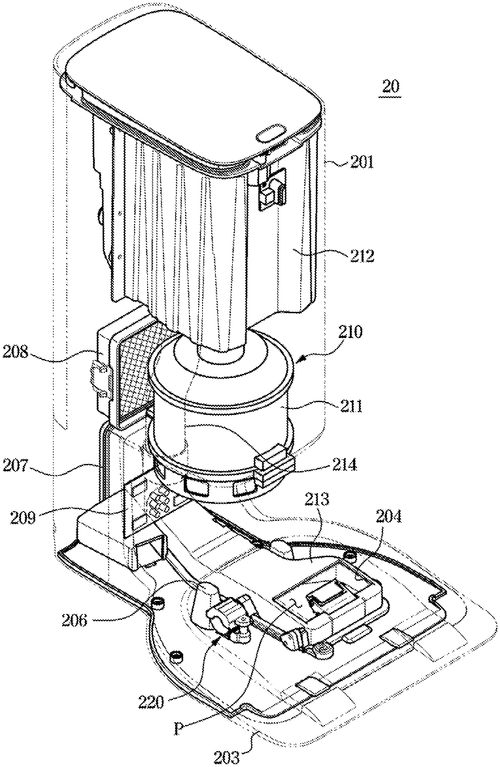
In a recent patent filing by Samsung Electronics Co., Ltd., a new cleaning system has been revealed. This system includes a robot cleaner with a unique dust collecting device that can open and close to release dirt, along with a station that generates suction force to collect the dirt. The station also features a lever device that connects with the robot cleaner to facilitate the transfer of dirt. This innovation by Samsung may rival existing robot cleaner products on the market, offering a more efficient and user-friendly cleaning experience. Imagine a future where your robot cleaner seamlessly connects with a station to dispose of dirt, eliminating the need for manual intervention. Will this new cleaning system from Samsung revolutionize the way we clean our homes? How would integrate this technology into your daily life? Share your thoughts in the comments below.
Abstract
Provided is a cleaning system including: a robot cleaner including a dust collecting device having a dirt outlet and an outlet door configured to open and close the dirt outlet; and a station including a collecting device configured to generate a suction force to suction dirt of the duct collecting device and a lever device provided with a lever configured to be fixable to the outlet door as the outlet door is being opened to allow the collecting device and the dust collecting device to communicate with each other, and a lever driving source configured to generate power for driving the lever. Provided is a cleaning system including: a robot cleaner including a dust collecting device having a dirt outlet and an outlet door configured to open and close the dirt outlet; and a station including a collecting device configured to generate a suction force to suction dirt of the duct collecting device and a lever device provided with a lever configured to be fixable to the outlet door as the outlet door is being opened to allow the collecting device and the dust collecting device to communicate with each other, and a lever driving source configured to generate power for driving the lever.
US Patent 12042118
SAMSUNG ELECTRONICS CO., LTD.
"Samsung's New Patent Revolutionizes Oxygen Saturation Estimation Technology"
What is this invention?
Apparatus and method for estimating oxygen saturation
Innovative device, a sensation,
Estimating oxygen saturation.
Sensor measures light waves,
Processor behaves,
For health, a crucial foundation.

Samsung Electronics Co., Ltd. has filed a patent for an interesting new apparatus that aims to estimate oxygen saturation levels. The device includes a sensor that measures optical signals of various wavelengths by emitting multi-wavelength light onto an object. A processor then analyzes these signals to determine a section for estimating oxygen saturation and eventually provides an estimate based on the collected data. While this technology shows promise in the medical field for monitoring oxygen levels in patients, it faces competition from existing pulse oximeters and similar devices. However, the potential uses for this apparatus could expand beyond healthcare to include fitness tracking, sports performance analysis, and even environmental monitoring. Will Samsung be able to bring this innovative oxygen saturation estimation device to market and revolutionize how we track our health and performance metrics? Share your thoughts in the comments below!
Abstract
An apparatus for estimating oxygen saturation is provided. The apparatus may include a sensor configured to measure optical signals of multiple wavelengths based on emitting multi-wavelength light onto an object; and a processor configured to: determine a section of the optical signals for estimating the oxygen saturation based on a difference between at least two optical signals among the optical signals of the multiple wavelengths; and estimate the oxygen saturation based on the optical signals of the multiple wavelengths in the section. An apparatus for estimating oxygen saturation is provided. The apparatus may include a sensor configured to measure optical signals of multiple wavelengths based on emitting multi-wavelength light onto an object; and a processor configured to: determine a section of the optical signals for estimating the oxygen saturation based on a difference between at least two optical signals among the optical signals of the multiple wavelengths; and estimate the oxygen saturation based on the optical signals of the multiple wavelengths in the section.
US Patent 12042280
SAMSUNG ELECTRONICS CO., LTD.
"Samsung Electronics Patent Revolutionizes Quantum Dot Technology with Cadmium-Free Luminescent Peak"
What is this invention?
Core shell quantum dot, production method thereof, and electronic device including the same
In the quantum realm, a dot does shine,
With zinc, tellurium, and selenium fine,
No cadmium found in this glowing feat,
Luminescent peak, a wavelength sweet,
Quantum efficiency, a technology divine.
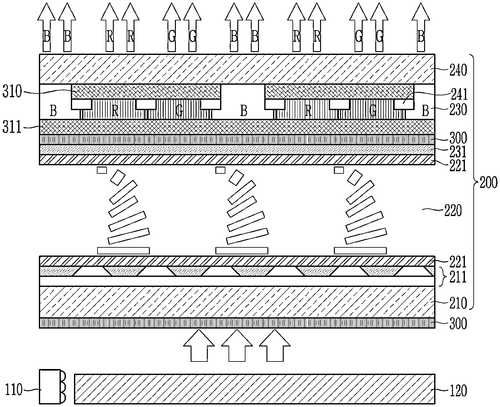
In a recent patent filed by Samsung Electronics Co., Ltd., a new quantum dot technology has been described. This quantum dot is composed of zinc, tellurium, and selenium, with a maximum luminescent peak in a wavelength range greater than 470 nanometers and a high quantum efficiency of over 10%. Notably, this quantum dot does not contain cadmium. This innovation could potentially shake up the display technology market, offering a more environmentally friendly alternative to traditional quantum dots that often contain cadmium. Competitors such as LG and Sony, known for their cutting-edge displays, may need to keep a close eye on this development. Imagine the possibilities of this technology in the next generation of high-definition displays or even in medical imaging devices where precise and efficient luminescence is crucial. As we eagerly await to see if this patent will materialize into a market-ready product, one can't help but wonder: How might this quantum dot technology revolutionize the way we interact with screens in our daily lives? Share your thoughts in the comments below.
Abstract
A quantum dot comprising zinc, tellurium, and selenium and not comprising cadmium, wherein a maximum luminescent peak of the quantum dot is present in a wavelength range of greater than about 470 nanometers (nm) and a quantum efficiency of the quantum dot is greater than or equal to about 10%, and wherein the quantum dot comprises a core comprising a first semiconductor nanocrystal and a semiconductor nanocrystal shell disposed on the core. A quantum dot comprising zinc, tellurium, and selenium and not comprising cadmium, wherein a maximum luminescent peak of the quantum dot is present in a wavelength range of greater than about 470 nanometers (nm) and a quantum efficiency of the quantum dot is greater than or equal to about 10%, and wherein the quantum dot comprises a core comprising a first semiconductor nanocrystal and a semiconductor nanocrystal shell disposed on the core.
US Patent 12043780
SAMSUNG ELECTRONICS CO., LTD.
"Samsung's New Clothes Care Apparatus Revolutionizes Water Management in Laundry Appliances"
What is this invention?
Clothes care apparatus
In a clothes care apparatus so neat,
Drain and recovery paths discreetly meet,
A heat exchanger condenses the air,
Water collected with precision and care,
Tech wizardry making laundry a feat.

Samsung Electronics Co., Ltd. has recently patented a clothes care apparatus that sets itself apart with a unique design feature. The apparatus boasts separate drain and recovery flow passages, ensuring efficient water management during the clothes care process. In a market saturated with traditional clothes care appliances, Samsung's innovation presents a fresh perspective on garment maintenance. By condensing air within the main body and collecting water on a heat exchanger, this apparatus offers a more controlled approach to moisture extraction. The inclusion of a pump to facilitate water removal further streamlines the process, promising convenience to users. With a drain container featuring an intelligent water level sensor and an overflow hole for optimal discharge, Samsung's clothes care apparatus appears to prioritize functionality and user experience. The potential applications of such a system could revolutionize home garment care routines, offering a more effective and hassle-free solution than current competitor products on the market. As readers consider the implications of Samsung's latest patent, it begs the question: Will this innovative clothes care apparatus see the light of day in consumer households, or will it remain a mesmerizing concept confined to patent documents? Share your thoughts on the practicality and desirability of such a product in the comments below.
Abstract
A clothes care apparatus in which a drain flow passage and a recovery flow passage are configured independently of each other. The clothes care apparatus includes a main body, a heat exchanger disposed inside the main body and configured to condense air inside the main body, a water collecting duct configured to collect water condensed on the heat exchanger, a pump configured to pump out the water collected in the water collecting duct, a drain container configured to store the pumped water introduced from the water collecting duct by the pump and including an inlet through which water is introduced and an overflow hole disposed below the inlet and configured to discharge the stored water in the drain container, and a water level sensor disposed inside the drain container, configured to detect a water level in the drain container, and disposed below the overflow hole. A clothes care apparatus in which a drain flow passage and a recovery flow passage are configured independently of each other. The clothes care apparatus includes a main body, a heat exchanger disposed inside the main body and configured to condense air inside the main body, a water collecting duct configured to collect water condensed on the heat exchanger, a pump configured to pump out the water collected in the water collecting duct, a drain container configured to store the pumped water introduced from the water collecting duct by the pump and including an inlet through which water is introduced and an overflow hole disposed below the inlet and configured to discharge the stored water in the drain container, and a water level sensor disposed inside the drain container, configured to detect a water level in the drain container, and disposed below the overflow hole.
US Patent 12043948
SAMSUNG ELECTRONICS CO., LTD.
"Samsung Patents Innovative Rotary Compressor Design for Efficient Refrigerant Compression"
What is this invention?
Rotary compressor and home appliance including the same
In a rotary compressor's dance,
With its parts in a tight romance,
Flange and muffler play their part,
Oil and refrigerant they impart,
In their intricate technological advance.
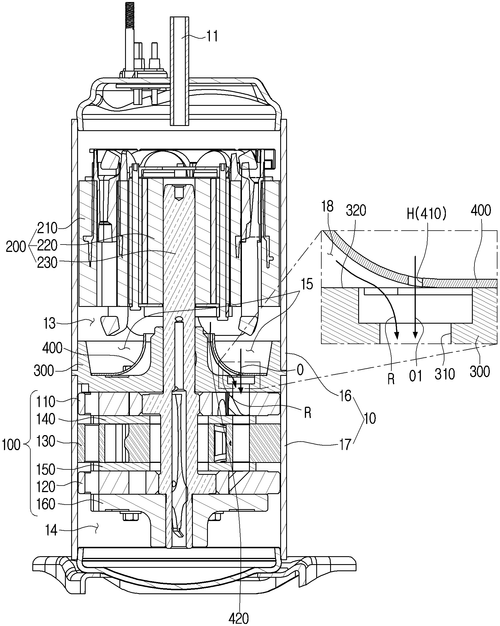
In the world of refrigeration technology, Samsung Electronics Co., Ltd. has introduced a new rotary compressor that may revolutionize the way we think about cooling systems. This compressor features innovative design elements such as partitioning the inner portion of the case into low and high-pressure regions, as well as incorporating specialized flange and muffler members to enhance efficiency. Competitor's products such as traditional compressors may soon face stiff competition from this new rotary compressor, which appears to offer improved performance and functionality. Imagine the potential uses of this technology in various industries, from residential air conditioning units to commercial refrigeration systems. The inclusion of features like separate oil and refrigerant flow paths suggests a focus on reliability and maintenance ease. However, the practicality and viability of mass-producing this rotary compressor remain to be seen. Will Samsung be able to bring this innovative concept to market successfully, or will it remain a patented idea on paper? Share your thoughts and predictions in the comments below.
Abstract
A rotary compressor includes a compression device including a compression space to accommodate a refrigerant introduced through an inlet, and configured to compress the refrigerant and to discharge the refrigerant to an outlet, a driving device to drive the compression device, a flange member to partition an inner portion of the case into a low-pressure region and a high-pressure region, and a muffler member disposed on a surface of the flange member to form a first space to store oil and a second space. The flange member includes a first hole communicating with the second space to allow the low-pressure region to communicate with the compression space, the muffler member includes a second hole which forms part of a refrigerant flow path, and at least one of the flange member and the muffler member includes a third hole which forms part of an oil flow path. A rotary compressor includes a compression device including a compression space to accommodate a refrigerant introduced through an inlet, and configured to compress the refrigerant and to discharge the refrigerant to an outlet, a driving device to drive the compression device, a flange member to partition an inner portion of the case into a low-pressure region and a high-pressure region, and a muffler member disposed on a surface of the flange member to form a first space to store oil and a second space. The flange member includes a first hole communicating with the second space to allow the low-pressure region to communicate with the compression space, the muffler member includes a second hole which forms part of a refrigerant flow path, and at least one of the flange member and the muffler member includes a third hole which forms part of an oil flow path.
US Patent 12044224
Apple Inc.
"Apple's New Patent Revolutionizes Wearable Technology with Innovative Human Tissue Proximity Detection Feature"
What is this invention?
Devices having matter differentiation detectors
There once was a wearable so fine,
With emitters and detectors to shine,
It emits beams of IR light,
To detect if it's out of sight,
A marvel of tech design!
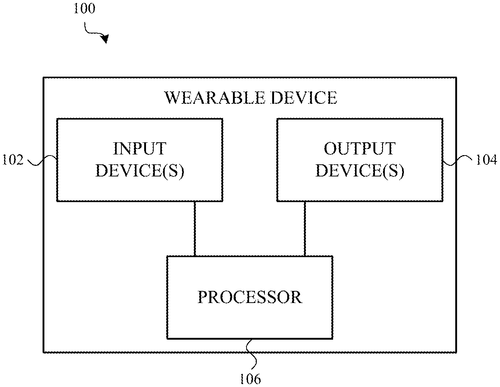
Apple Inc.'s latest patent reveals a potential game-changer in the wearable tech industry. This innovative device features dual emitters that emit different wavelengths of infrared radiation to detect human tissue proximity, all cleverly integrated into a sleek wristband design. Competitors in the market, such as Fitbit and Garmin, may need to up their game if this patent comes to fruition. Imagine the convenience of a wearable device that can accurately differentiate between the device being worn on the wrist or in close contact with skin, opening up possibilities for improved health tracking and biometric authentication. But, as with all patents, the big question remains: Will Apple bring this concept to life? How would you envision integrating this technology into your daily life? Share your thoughts in the comments below.
Abstract
A wearable device includes a housing; a wrist band attached to the housing; first and second emitters positioned within the housing and configured to respectively emit, through a back of the housing, a first beam of electromagnetic radiation having a first infrared (IR) wavelength and a second beam of electromagnetic radiation having a second IR wavelength. The second IR wavelength is different from the first IR wavelength. The wearable device also includes a photodetector positioned within the housing and filtered to detect a set of electromagnetic radiation wavelengths including the first IR wavelength and the second IR wavelength; and a matter differentiation circuit configured to indicate, at least partly in response to signals indicating amounts of the first IR wavelength and the second IR wavelength received by the photodetector, whether the back of the housing is likely proximate to human tissue. A wearable device includes a housing; a wrist band attached to the housing; first and second emitters positioned within the housing and configured to respectively emit, through a back of the housing, a first beam of electromagnetic radiation having a first infrared (IR) wavelength and a second beam of electromagnetic radiation having a second IR wavelength. The second IR wavelength is different from the first IR wavelength. The wearable device also includes a photodetector positioned within the housing and filtered to detect a set of electromagnetic radiation wavelengths including the first IR wavelength and the second IR wavelength; and a matter differentiation circuit configured to indicate, at least partly in response to signals indicating amounts of the first IR wavelength and the second IR wavelength received by the photodetector, whether the back of the housing is likely proximate to human tissue.
US Patent 12042255
Apple Inc.
"Apple's New Patent Revolutionizes Physiological Signal Detection in Mobile Devices"
What is this invention?
Contact detection for physiological sensor
Innovative tech, electrodes at play,
Physiological signals not astray.
Wearable wonders, with circuitry grand,
User contact detected, waveform in hand.
Ensuring signals clinically accurate each day.
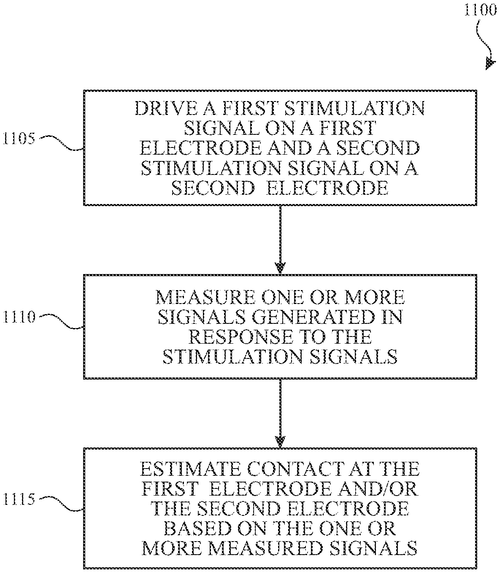
In a recent patent by Apple Inc., a new innovation has been described that could revolutionize the way physiological signals are measured using mobile and wearable devices. The technology allows for the detection of user contact with electrodes on a sensor to ensure the accuracy of the measured signals. This advancement could potentially lead to more clinically accurate data being collected, especially in comparison to current competitor products on the market. Imagine a smartwatch that not only tracks your steps but also monitors your heart rate with clinical precision, all through simple contact with your skin. However, as with many patents, the question remains: Will this technology actually make its way into a real product that consumers can buy? Apple has a history of pushing the boundaries of innovation, but only time will tell if this particular invention will see the light of day. What do you think? Would you be interested in a wearable device that could monitor your physiological signals with such accuracy? Let us know in the comments below!
Abstract
Detecting user contact with one or more electrodes of a physiological signal sensor can be used to ensure physiological signals measured by the physiological signal sensor meet waveform characteristics (e.g., of a clinically accurate physiological signal). In some examples, a mobile and/or wearable device can comprise sensing circuitry, stimulation circuitry, and processing circuitry. The stimulation circuit can drive one or more stimulation signals on one or more electrodes, the resulting signal(s) can be measured (e.g., by the sensing circuitry), and the processing circuitry can determine whether a user is in contact with the electrode(s). Additionally or alternatively, in some examples, mobile and/or wearable device can comprise saturation detection circuitry, and the processing circuitry can determine whether the sensing circuitry is saturated. Detecting user contact with one or more electrodes of a physiological signal sensor can be used to ensure physiological signals measured by the physiological signal sensor meet waveform characteristics (e.g., of a clinically accurate physiological signal). In some examples, a mobile and/or wearable device can comprise sensing circuitry, stimulation circuitry, and processing circuitry. The stimulation circuit can drive one or more stimulation signals on one or more electrodes, the resulting signal(s) can be measured (e.g., by the sensing circuitry), and the processing circuitry can determine whether a user is in contact with the electrode(s). Additionally or alternatively, in some examples, mobile and/or wearable device can comprise saturation detection circuitry, and the processing circuitry can determine whether the sensing circuitry is saturated.
US Patent 12042301
Apple Inc.
"Apple's New Patent Revolutionizes Illumination Technology with Electrically Adjustable Shutter System"
What is this invention?
Lights with microlens arrays
In a system where lights shine bright,
Collimated beams in the night,
With lenses that shape,
The light takes its drape,
Adjustable shutters, what a sight!
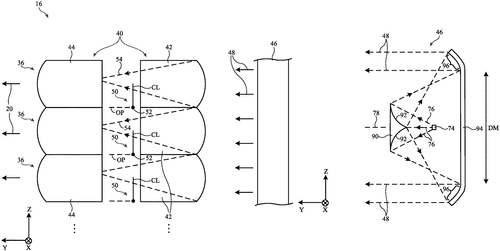
In a recent patent application by Apple Inc., a new system involving lights that produce illumination has been described. The system includes a collimated light source that utilizes lenses or reflective optical elements to produce the light. Each light in the system consists of an array of light elements, with individual preshaping lenses and output lenses to control the beam of illumination. Additionally, an electrically adjustable shutter is placed between the lenses to adjust the light output between low-beam and high-beam patterns. This innovative technology could potentially revolutionize the automotive industry by enhancing the performance of vehicle headlights. In a market where competitors like Tesla are constantly striving to improve energy efficiency and safety features, Apple's patented system has the potential to set a new standard for lighting systems in cars. Imagine the impact this technology could have on nighttime driving, providing drivers with improved visibility and safety on the road. However, the question remains: Will Apple be able to successfully bring this patented system to market and offer it as a product for consumers to experience firsthand? Share your thoughts in the comments below.
Abstract
A system may have lights produce illumination. A light may be provided with a collimated light source that produces collimated light. The collimated light source may use lenses or reflective optical elements to produce the collimated light. The light may have an array of light elements each of which emits a respective beam of the illumination. Each light element may have a preshaping lens that receives the collimated light and produces corresponding preshaped output light and an output lens that receives the output light from the preshaping lens and produces a corresponding beam of the illumination. An electrically adjustable shutter may be located between each preshaping lens and output lens to adjust the illumination between a low-beam pattern and high-beam pattern. A system may have lights produce illumination. A light may be provided with a collimated light source that produces collimated light. The collimated light source may use lenses or reflective optical elements to produce the collimated light. The light may have an array of light elements each of which emits a respective beam of the illumination. Each light element may have a preshaping lens that receives the collimated light and produces corresponding preshaped output light and an output lens that receives the output light from the preshaping lens and produces a corresponding beam of the illumination. An electrically adjustable shutter may be located between each preshaping lens and output lens to adjust the illumination between a low-beam pattern and high-beam pattern.
US Patent 12044373
Apple Inc.
"Wearable Tech Innovation: Apple's Patented Gesture-Controlled Illumination System"
What is this invention?
Systems with adjustable lights
In a room with tech innovation,
Lighting dances with sensation.
Gestures bring forth the light,
Changing elements' plight,
In a symphony of modernization.
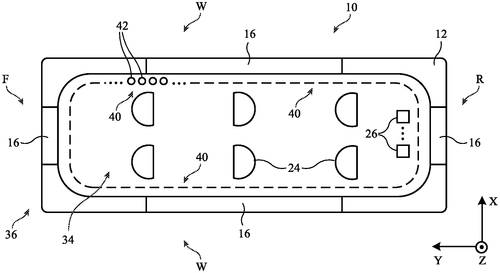
Apple Inc. has recently filed a patent for a futuristic system that combines lighting and gesture sensors to create an interactive interior experience. The system utilizes light-emitting diodes arranged in strips or patterns to provide illumination, while a touch or proximity sensor detects gestures made over the lights. This technology allows users to control the lighting by toggling the states of the diodes based on their gestures. While this invention sounds like something out of a sci-fi movie, it raises questions about its practicality and potential uses in our daily lives. How could this innovative system enhance the functionality of smart homes or be integrated into virtual reality experiences? Could it revolutionize the way we interact with our environments? As we wait to see if Apple will bring this concept to market, it's exciting to think about the possibilities that such a cutting-edge technology could offer. What are your thoughts on this patent? How do you envision this technology being used in the future? Share your ideas in the comments below.
Abstract
A system may have an interior region. The system may have lighting that provides illumination for the interior region. The lighting may include light-emitting elements such as light-emitting diodes arranged in strips or two-dimensional patterns. A gesture sensor such as a touch gesture sensor or proximity gesture sensor may overlap the light-emitting diodes. As gesture input is received over the light-emitting elements, the lighting may toggle the states of the light-emitting elements, turning on elements that are off and turning off elements that are on. The lighting may toggle the states of the elements based on gesture input such as gesture input made along a strip of elements or gesture input involving gestures that pass over a selected set of elements in a two-dimensional array. A system may have an interior region. The system may have lighting that provides illumination for the interior region. The lighting may include light-emitting elements such as light-emitting diodes arranged in strips or two-dimensional patterns. A gesture sensor such as a touch gesture sensor or proximity gesture sensor may overlap the light-emitting diodes. As gesture input is received over the light-emitting elements, the lighting may toggle the states of the light-emitting elements, turning on elements that are off and turning off elements that are on. The lighting may toggle the states of the elements based on gesture input such as gesture input made along a strip of elements or gesture input involving gestures that pass over a selected set of elements in a two-dimensional array.
US Patent 12044391
Apple Inc.
"Innovative Apple Patent Enhances Accuracy of Ranging in Wireless Devices"
What is this invention?
Electronic devices with low signal-to-noise ratio range measurement capabilities
In the realm of wireless circuitry,
Sensing signals create a flurry,
Mixers generate beats,
Range finding feats,
In low noise, accuracy isn't a worry.
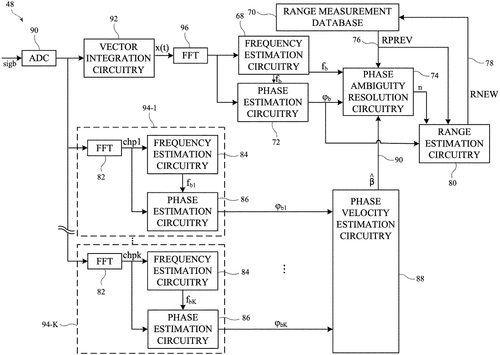
Apple Inc. has been granted a patent for an intriguing electronic device that utilizes radio-frequency sensing signals to accurately measure the distance between the device and an external object. This cutting-edge technology aims to provide precise range measurements even in challenging signal environments, such as when the external object is in motion relative to the device. The patent suggests that this innovation could potentially revolutionize the way electronic devices interact with their surroundings. Imagine a smartphone equipped with this technology being able to offer enhanced augmented reality experiences by accurately sensing distances to objects in real-time. Additionally, this technology could have applications in autonomous vehicles to improve object detection and avoidance systems. Competitors in the tech industry, such as Samsung and Google, may need to keep a close eye on Apple's developments in this space to stay competitive in the ever-evolving market for smart devices. As we anticipate the future integration of this technology into consumer products, one can't help but wonder: How might this advanced sensing capability impact the way we interact with our devices on a daily basis? What new possibilities could open up with such precise range measurement capabilities? Share your thoughts in the comments below.
Abstract
An electronic device may include wireless circuitry with sensing circuitry that transmits radio-frequency sensing signals and receives reflected radio-frequency sensing signals. A mixer may generate a series of beat signals based on the sensing signals and the reflected sensing signals. The sensing circuitry may generate a beat phase based on an average of the series of beat signals, a set of phase values based on the series of beat signals, and a phase velocity based on the set of phase values. The sensing circuitry may resolve a phase ambiguity in the beat phase based on the phase velocity to identify a range between the electronic device and an external object. This way may allow the sensing circuitry to generate accurate ranges even in a low signal-to-noise ratio regime, such as when the external object is moving relative to the electronic device. An electronic device may include wireless circuitry with sensing circuitry that transmits radio-frequency sensing signals and receives reflected radio-frequency sensing signals. A mixer may generate a series of beat signals based on the sensing signals and the reflected sensing signals. The sensing circuitry may generate a beat phase based on an average of the series of beat signals, a set of phase values based on the series of beat signals, and a phase velocity based on the set of phase values. The sensing circuitry may resolve a phase ambiguity in the beat phase based on the phase velocity to identify a range between the electronic device and an external object. This way may allow the sensing circuitry to generate accurate ranges even in a low signal-to-noise ratio regime, such as when the external object is moving relative to the electronic device.
US Patent 12044769
International Business Machines Corporation
"Innovative IBM Patent Revolutionizes Reservoir Connectivity Through Trench Technology"
What is this invention?
Precision fabrication of nanosieves
In technology's dance, we employ
A method with layers to deploy,
Trenches indented, fill layers air-tight,
Gaps formed with precision to alight,
Connecting reservoirs in seamless joy.
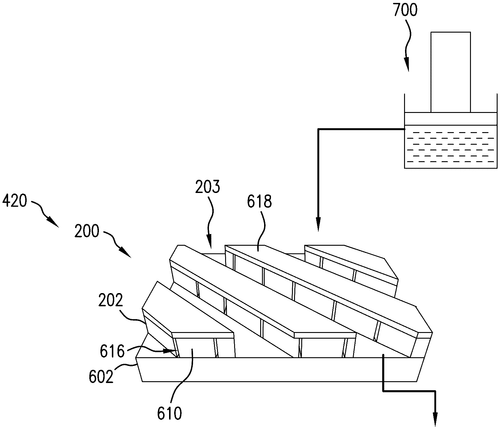
A new patent filed by International Business Machines Corporation describes an innovative method involving the formation of an array of gaps within a substrate, potentially revolutionizing fluid communication processes. This method involves intricate steps like forming a sacrificial layer, depositing a fill layer, and creating gaps between the layers to allow fluid movement. While this patent showcases forward-thinking technology, the practical application and scalability of such a method remain to be seen. Competing products in the market may offer similar functionalities, raising questions about the unique value proposition of this invention. However, if successfully implemented, this method could have diverse applications across industries such as microfluidics, medical devices, and even electronics manufacturing. Imagine tiny reservoirs communicating through a network of channels within a device, enabling precise control over fluid flow for various purposes. The question remains: Will this patent pave the way for a groundbreaking product that changes the game in fluid management systems? Share your thoughts on the potential impact of this technology and how it could shape future innovations in the comments below.
Abstract
An exemplary method includes forming a sacrificial layer along sidewalls of an array of trenches that are indented into a substrate, depositing a fill layer over the sacrificial layer, and then creating an array of gaps between the fill layer and the substrate by removing the sacrificial layer along the sidewalls of the trenches, while maintaining a structural connection between the substrate and the fill layer at the floors of the trenches. The method further includes covering the substrate, the fill layer, and the gaps with a cap layer that seal fluid-tight against the substrate and the fill layer. The method further includes indenting a first reservoir and a second reservoir through the cap layer, and into the substrate and the fill layer, across the lengths of the array of gaps, so that the array of gaps connects the first reservoir in fluid communication with the second reservoir. An exemplary method includes forming a sacrificial layer along sidewalls of an array of trenches that are indented into a substrate, depositing a fill layer over the sacrificial layer, and then creating an array of gaps between the fill layer and the substrate by removing the sacrificial layer along the sidewalls of the trenches, while maintaining a structural connection between the substrate and the fill layer at the floors of the trenches. The method further includes covering the substrate, the fill layer, and the gaps with a cap layer that seal fluid-tight against the substrate and the fill layer. The method further includes indenting a first reservoir and a second reservoir through the cap layer, and into the substrate and the fill layer, across the lengths of the array of gaps, so that the array of gaps connects the first reservoir in fluid communication with the second reservoir.
US Patent 12042770
International Business Machines Corporation
"IBM's Innovative Toroidal Item Storage System Revolutionizes Inventory Management"
What is this invention?
Cognitive rotatable item storage with automated replenishment
In a storage system so pristine,
Shelves with toroidal sheen,
An elevator's the star,
Loading items near and far,
Efficient design, a tech dream.
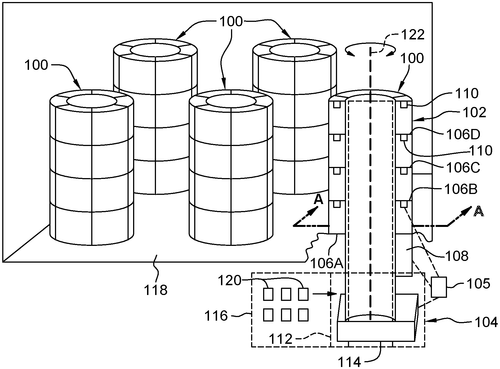
A new patent from International Business Machines Corporation introduces an innovative item storage system that utilizes a unique shelving design and replenishment mechanism. The system features toroidal-shaped shelves, with an elevator portion positioned at the center to deliver items to different levels. This setup allows for efficient storage and retrieval of items in a compact space. Competitors in the storage solutions market, such as Amazon's warehouse robotics or automated storage systems from companies like Fetch Robotics, may face some competition if this invention is brought to market. The toroidal design offers a different approach to item storage, potentially offering advantages in terms of space utilization and ease of access. Imagine the application of this system in retail warehouses or fulfillment centers, where efficient storage and retrieval are crucial for meeting customer demand. The unique design could revolutionize the way inventory is managed and processed in such environments, streamlining operations and improving productivity. As we look to the future of storage technology, could this patent pave the way for a new standard in item storage systems? How do you think this innovative design could impact the efficiency of storage operations in various industries? Share your thoughts in the comments below.
Abstract
An item storage system includes a shelving portion and a replenishment portion. The shelving portion includes: a first shelf having a toroidal shape with a center axis; and a second shelf having a toroidal shape that is spaced apart from the first shelf along the center axis. The replenishment portion includes: an elevator portion configured to deliver items to the first shelf and the second shelf, wherein at least part of the elevator portion is positioned in the center of the shelving portion and is surrounded by the shelving portion; and a storing portion configured to load items into the elevator portion, wherein the storing portion is positioned above or below the shelving portion. An item storage system includes a shelving portion and a replenishment portion. The shelving portion includes: a first shelf having a toroidal shape with a center axis; and a second shelf having a toroidal shape that is spaced apart from the first shelf along the center axis. The replenishment portion includes: an elevator portion configured to deliver items to the first shelf and the second shelf, wherein at least part of the elevator portion is positioned in the center of the shelving portion and is surrounded by the shelving portion; and a storing portion configured to load items into the elevator portion, wherein the storing portion is positioned above or below the shelving portion.
US Patent 12043482
International Business Machines Corporation
"Innovative Technology Manages Rechargeable Battery Storage for Extended Lifespan"
What is this invention?
Battery state of charge management for storage
Invention's brilliance shines bright,
Managing battery charge day and night,
Historical data in sight,
Preserving power, such a delight,
Innovative tech, a storage protocol's might.
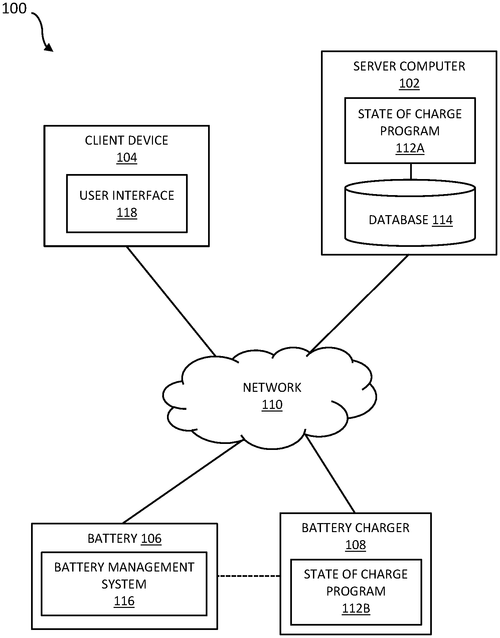
In a world where battery life is a crucial factor in our everyday devices, a recent patent from International Business Machines Corporation offers a promising solution for managing the state of charge of rechargeable batteries for extended storage. This innovation involves determining when to activate a storage protocol for a rechargeable battery based on various data inputs, ultimately discharging the battery to a preset level to optimize its longevity. While competitors like Apple and Samsung have made strides in improving battery technology, this patent introduces a new layer of sophistication in battery management. Imagine never having to worry about your device sitting idle for extended periods and losing battery life in the process. This technology could potentially revolutionize how we store and maintain rechargeable batteries in our devices. However, as with any patent, the question remains: will this innovation make its way into actual products? How soon might we see this technology implemented in our smartphones, laptops, and other electronic devices? Share your thoughts and predictions in the comments below.
Abstract
Embodiments of the present invention manage a state of charge of a rechargeable battery for extended storage by determining a manual override for a storage protocol is not activate for a rechargeable battery associated with a battery charger and an electronic device. Receiving battery data, environment data, and historical data for the rechargeable battery associated with a battery charger. Embodiments of the present invention determine to activate the storage protocol for the rechargeable battery based on the battery data, the environment data, and the historical data and discharge the rechargeable battery to a preset state of charge level based on the storage protocol. Embodiments of the present invention manage a state of charge of a rechargeable battery for extended storage by determining a manual override for a storage protocol is not activate for a rechargeable battery associated with a battery charger and an electronic device. Receiving battery data, environment data, and historical data for the rechargeable battery associated with a battery charger. Embodiments of the present invention determine to activate the storage protocol for the rechargeable battery based on the battery data, the environment data, and the historical data and discharge the rechargeable battery to a preset state of charge level based on the storage protocol.
US Patent 12044739
International Business Machines Corporation
"Innovative Patent Revolutionizes Stale Data Recovery with Virtual Storage Metadata"
What is this invention?
Stale data recovery using virtual storage metadata
Innovation unfolds in a limerick tale,
Stale data recovery set to prevail.
Virtual storage, metadata in play,
Update sequences leading the way.
Overflow structure, data's holy grail.
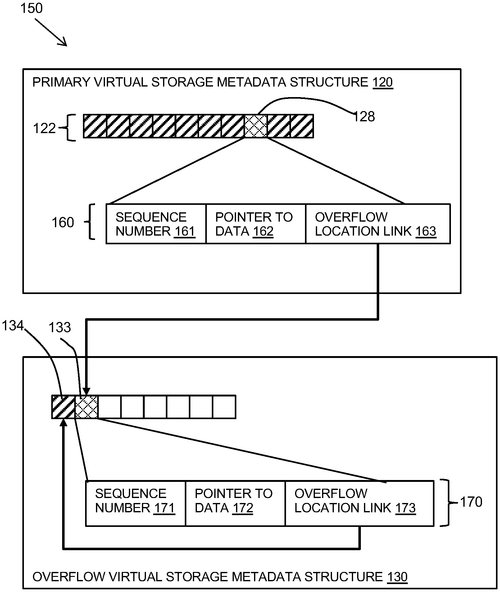
In a recent patent filed by International Business Machines Corporation, a cutting-edge method for stale data recovery using virtual storage metadata has been unveiled. The proposed system involves generating virtual storage metadata structures to track and recover data chunks efficiently. This innovation could potentially revolutionize data management and storage systems, providing a more streamlined and effective approach to handling vast amounts of information. With competitors in the tech industry constantly pushing boundaries in data storage solutions, IBM's patent presents a promising solution that could give them a competitive edge. Imagine the practical applications of this technology in cloud storage services, database management, and network infrastructure. The ability to quickly retrieve and update data without the risk of loss or corruption could significantly enhance the efficiency and reliability of digital systems. However, the question remains: Will this patented method for stale data recovery using virtual storage metadata be successfully integrated into real-world products and services? How will it impact the data management landscape moving forward? Share your thoughts in the comments below.
Abstract
Aspects of the present invention disclose a method, computer program product, and system for stale data recovery using virtual storage metadata. The method includes one or more processors generating a primary virtual storage metadata structure having virtual address areas for a data chunk. Each area includes a plurality of most recent updates of metadata for the data chunk. The metadata of each update includes a sequence number for the update and a pointer to the physical location of the data. The method further includes one or more processors generating an overflow virtual storage metadata structure for multiple virtual address areas. The overflow metadata structure includes updates that have overflowed from the virtual address areas. In addition, wherein an oldest update in a full virtual address area of the primary virtual storage metadata structure includes a link to an overflow location. Aspects of the present invention disclose a method, computer program product, and system for stale data recovery using virtual storage metadata. The method includes one or more processors generating a primary virtual storage metadata structure having virtual address areas for a data chunk. Each area includes a plurality of most recent updates of metadata for the data chunk. The metadata of each update includes a sequence number for the update and a pointer to the physical location of the data. The method further includes one or more processors generating an overflow virtual storage metadata structure for multiple virtual address areas. The overflow metadata structure includes updates that have overflowed from the virtual address areas. In addition, wherein an oldest update in a full virtual address area of the primary virtual storage metadata structure includes a link to an overflow location.
US Patent 12045173
****
"Innovative Shovel Design Revolutionizes Digging Efficiency"
What is this invention?
Shovel for debris removal
Innovative shovel, a device so grand,
With handle, support, and blade so well planned,
Arms symmetrically arranged with grace,
Reinforcing rod in the shaft's embrace,
New technology in digging land!
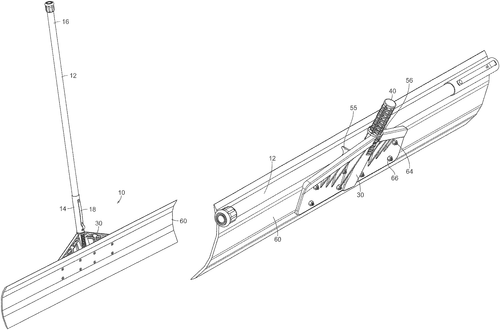
A newly patented shovel design is shaking up the world of gardening and landscaping tools, promising a sturdier and more efficient digging experience. This innovative shovel features a unique support assembly with a flat mounting base and symmetrically arranged arms connected to a shaft at an angle. The shaft boasts a hollow channel with a reinforcing rod inside, ensuring durability and strength during use. Competing with traditional shovels on the market, this new design aims to provide users with a more ergonomic and reliable tool for various outdoor tasks. Imagine effortlessly digging through tough soil or scooping up heavy loads with ease, thanks to the reinforced structure of this shovel. But will this patent make its way from concept to production? Will we soon see this revolutionary shovel in the hands of gardeners and landscapers everywhere? Share your thoughts on the practicality and potential impact of this invention in the comments below.
Abstract
A shovel is provided having a handle, a support assembly and a blade. The support assembly comprises a substantially flat mounting base adapted for connection to the blade and having first and second ends and front and rear regions. A shaft positioned at first angle to the base. First and second arms symmetrically arranged with respect to the shaft. The first arm connects the first end of the base with a central region of the shaft, and the second connects the second end of the base with a central region of the shaft. The shaft is formed with a hollow channel with a reinforcing rod disposed within the channel. A shovel is provided having a handle, a support assembly and a blade. The support assembly comprises a substantially flat mounting base adapted for connection to the blade and having first and second ends and front and rear regions. A shaft positioned at first angle to the base. First and second arms symmetrically arranged with respect to the shaft. The first arm connects the first end of the base with a central region of the shaft, and the second connects the second end of the base with a central region of the shaft. The shaft is formed with a hollow channel with a reinforcing rod disposed within the channel.
US Patent 12041865
****
"Innovative Sensor-Equipped Press Wheel Patent Revolutionizes Agricultural Planting Efficiency"
What is this invention?
Press wheel assembly for delicate seed planting and data acquisition for a seed planter
In the field of tech innovation bright,
A press wheel with sensors detects just right,
Connected to a device so supreme,
Determining spacings with gleam,
Adjusting speed on the fly in its light.
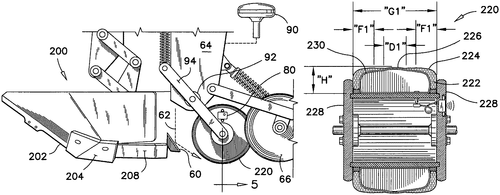
Farmers and agricultural enthusiasts, get ready to revolutionize the way you plant crops with a groundbreaking new patent that combines innovation and practicality. This patent describes a press wheel equipped with advanced instrumentation that can detect the rolling of the wheel over a planted set, providing real-time data to the planter operator. The computing device connected to the instrumentation calculates the spacings between planted sets, allowing for on-the-fly adjustments to the planter speed to maintain ideal set spacing. Imagine a world where farmers can ensure precise planting without the risk of damaging the crops, thanks to the press wheel's soft, smooth, flexible, and stretchable rolling surface. Competing with traditional planting methods, this invention promises a seamless experience where the "rolling on" and "rolling away" from planted sets are equally smooth. But will this cutting-edge technology make its way from patent to production? How might this invention impact the future of precision agriculture and crop yields? Share your thoughts in the comments below.
Abstract
The press wheel has instrumentation associated therewith detecting a rolling of the wheel over a planted set. A computing device is connected to the instrumentation and to the speed monitoring device of the planter. The computing device determines spacings between planted sets. The data obtained is real-time data and is readily available to the operator of the planter so that the speed of the planter can be adjusted on the fly to maintain an ideal set spacing. The press wheel has a soft, smooth, flexible and stretchable rolling surface capable of deforming over a planted set and detecting an imprint of the planted set in the surface thereof, without damaging the planted set. A contact signature of the rolling of the press wheel over a planted set shows that the “rolling on” of the press wheel over a planted set is as smooth as the “rolling away” from the planted set. The press wheel has instrumentation associated therewith detecting a rolling of the wheel over a planted set. A computing device is connected to the instrumentation and to the speed monitoring device of the planter. The computing device determines spacings between planted sets. The data obtained is real-time data and is readily available to the operator of the planter so that the speed of the planter can be adjusted on the fly to maintain an ideal set spacing. The press wheel has a soft, smooth, flexible and stretchable rolling surface capable of deforming over a planted set and detecting an imprint of the planted set in the surface thereof, without damaging the planted set. A contact signature of the rolling of the press wheel over a planted set shows that the “rolling on” of the press wheel over a planted set is as smooth as the “rolling away” from the planted set.
US Patent 12041870
****
"Revolutionizing Lawn Care: New Finger-Bar Mower Design with Reciprocating Blades!"
What is this invention?
Finger-bar-type mower with center drive
In a mower, blades reciprocate with ease,
Left and right, cutting grass with expertise,
Connection gear and reduction in play,
Shaft rotating, guiding the blade's way,
With wheels for support, it works with grace.

A new patent has been unveiled for a finger-bar-type mower that boasts a unique design in which blades move back and forth to efficiently trim grass. This innovative mower features a sophisticated system including connection gears, reduction gears, a rotating shaft, and a bridge for support. The blade, equipped with cutting edges, is connected to the shaft and moves in a left and right motion, with wheels attached to guide its path. While this invention showcases promising advancements in lawn care technology, it will be interesting to see how it measures up against existing competitor products on the market. Could this mower revolutionize the way we maintain our lawns, providing a more efficient and precise cutting experience? How might this new design impact the landscaping industry as a whole? Share your thoughts in the comments below.
Abstract
A finger-bar-type mower in which blades reciprocate left and right to mow grass. The mower includes: a connection gear which is power-connected to a driving means of the mower; a reduction gear connected to the connection gear; a shaft rotating according to rotation of the reduction gear; a bridge accommodating and supporting the connection gear and the reduction gear; a blade which is power-connected to the shaft and is reciprocated left and right according to rotation of the shaft, the blade including cutting edges; a guide part supporting the bridge and extending along the blade; and wheels respectively connected to both ends of the guide part. The shaft is disposed in center regions of the blade and the guide part. A finger-bar-type mower in which blades reciprocate left and right to mow grass. The mower includes: a connection gear which is power-connected to a driving means of the mower; a reduction gear connected to the connection gear; a shaft rotating according to rotation of the reduction gear; a bridge accommodating and supporting the connection gear and the reduction gear; a blade which is power-connected to the shaft and is reciprocated left and right according to rotation of the shaft, the blade including cutting edges; a guide part supporting the bridge and extending along the blade; and wheels respectively connected to both ends of the guide part. The shaft is disposed in center regions of the blade and the guide part.
US Patent 12041873
****
"Ingenious Patent Unveiled: Revolutionary Method Speeds Up Tree Potting Process"
What is this invention?
Method of planting a tree in a container, and an apparatus for potting a tree
There once was a tech-savvy crew
Who potted trees with a breakthrough
With a buffer and chute
They were quite astute
Making potting quicker to do
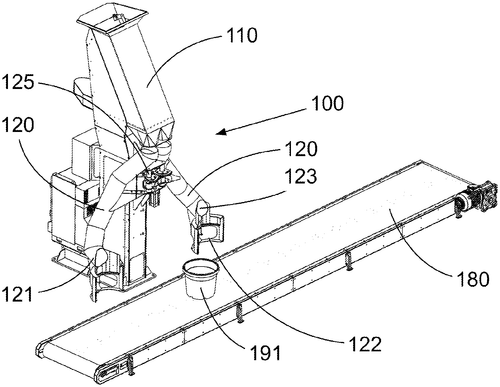
A new patent has been filed for a method of potting trees in a more efficient manner. This method involves inserting the tree's root system into a pot and using a special apparatus to supply a substrate to cover the roots. The apparatus includes a buffer and at least one chute for releasing the substrate into the pot by gravity in batches. This innovation could potentially revolutionize the tree potting industry by speeding up the process and ensuring a more uniform coverage of the roots. Competing products on the market may need to up their game to match this new method. Imagine the possibilities of using this invention in large-scale nurseries or urban landscaping projects. The efficiency and precision it offers could be a game-changer in these contexts. What other industries do you think could benefit from this type of automated potting technique? Let us know in the comments below!
Abstract
A method of potting a tree, wherein the method includes the steps of inserting the root system of the tree into the lumen of the pot, and supplying a particulate substrate to the pot to cover the root system using an apparatus including a supply system. To pot trees quicker, the supply system includes i) a buffer, and ii) at least one chute, wherein the method includes providing the buffer with a predetermined amount of particulate substrate, and batch-wise release of the particulate material in the buffer to provide the pot with the particulate material from the buffer via the at least one chute by gravity. A method of potting a tree, wherein the method includes the steps of inserting the root system of the tree into the lumen of the pot, and supplying a particulate substrate to the pot to cover the root system using an apparatus including a supply system. To pot trees quicker, the supply system includes i) a buffer, and ii) at least one chute, wherein the method includes providing the buffer with a predetermined amount of particulate substrate, and batch-wise release of the particulate material in the buffer to provide the pot with the particulate material from the buffer via the at least one chute by gravity.
US Patent 12041896
****
"Revolutionizing Agriculture: Patent Unveils Soybean Variety 5PLLA47 with Enhanced Traits"
What is this invention?
Soybean variety 5PLLA47
In labs where the tech wizards play,
A soybean variety, 5PLLA47, holds sway.
With seeds, cells, and plants in tow,
Methods for traits to sow and grow,
A new era for soybeans, here to stay!

In the competitive world of agriculture, a new patent has emerged, introducing a novel soybean variety known as 5PLLA47. This new variety comes with a range of offerings, including seeds, cells, plants, and plant parts. The methods outlined in the patent encompass various techniques such as crossbreeding, trait introgression, and plant production, all centered around the cultivation of soybean variety 5PLLA47. Potential applications for this innovation could revolutionize the soybean industry, from enhancing yield and resilience to introducing new traits that may benefit farmers and consumers alike. As competitors in the market continue to introduce their own soybean varieties, the emergence of 5PLLA47 brings a fresh perspective to the field. As we consider the implications of this new soybean variety, one cannot help but wonder: How will this patent shape the future of soybean farming practices and the global food supply chain? Join the conversation below and share your thoughts on the potential impact of this inventive development.
Abstract
A novel soybean variety, designated 5PLLA47 is provided. Also provided are the seeds of soybean variety 5PLLA47, cells from soybean variety 5PLLA47, plants of soybean 5PLLA47, and plant parts of soybean variety 5PLLA47. Methods provided include producing a soybean plant by crossing soybean variety 5PLLA47 with another soybean plant, methods for introgressing a transgenic trait, a mutant trait, and/or a native trait into soybean variety 5PLLA47, methods for producing other soybean varieties or plant parts derived from soybean variety 5PLLA47, and methods of characterizing soybean variety 5PLLA47. Soybean seed, cells, plants, germ plasm, breeding lines, varieties, and plant parts produced by these methods and/or derived from soybean variety 5PLLA47 are further provided. A novel soybean variety, designated 5PLLA47 is provided. Also provided are the seeds of soybean variety 5PLLA47, cells from soybean variety 5PLLA47, plants of soybean 5PLLA47, and plant parts of soybean variety 5PLLA47. Methods provided include producing a soybean plant by crossing soybean variety 5PLLA47 with another soybean plant, methods for introgressing a transgenic trait, a mutant trait, and/or a native trait into soybean variety 5PLLA47, methods for producing other soybean varieties or plant parts derived from soybean variety 5PLLA47, and methods of characterizing soybean variety 5PLLA47. Soybean seed, cells, plants, germ plasm, breeding lines, varieties, and plant parts produced by these methods and/or derived from soybean variety 5PLLA47 are further provided.
US Patent 12041903